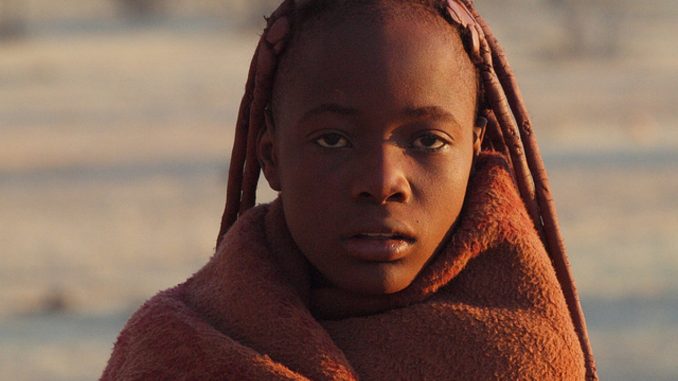
The Himba people of Northern Namibia cover their skin with a mixture of butter fat and ochre — a natural earth pigment containing iron oxide — to protect themselves from the sun. For that reason, the Himba people often appear to have a red skin tone.
Who are the Himba people?
The Himba are beautiful, hardworking and peaceful agro-pastoralists people that forms a sub-set of the larger Herero ethnolinguistic group residing in Kaokoland, a vast stretch of land in northwestern Namibia and bordered by Angola to the north and the Skeleton Coast and Atlantic Ocean to the west. The friendly and extraordinary Himba people are closely related to the Herero people but they have resisted change and preserved their unique cultural heritage. About 240,000 Herero people live in Namibia, Botswana and Angola. They belong to the Bantu group of African nations.
Like other tribes living in the area, people depend on their cows to live and as a result, a Himba man without a herd of bovine companions isn’t considered worthy of respect.
The Himbas were impoverished by Nama cattle raiders in the middle of 1800’s and then forced to be hunter-gatherers. Because of these events they were called the Tjimba, derived form the word meaning aardvark, the animal that digs for its food. Many Himbas fled to Angola where they were called Ovahimba, meaning ‘beggars’. They left with their leader called Vita (”war”). After World War 1 he resettled his people in Kaokoland. Since these events the Himbas were living their nomadic pastoralist lives. But now more and more they have to reconcile traditional ways with European values.
‘Despite the above stated fact and though they live in little villages, the Himba are rich people. ‘The herds can be anything up to 200 cows, although they will never says how many cows they have – they keep it secret to avoid thieves.’
The Himba’s egalitarianism also extends to who gets to be in charge of what, with decisions split between men and women. ‘The Himba have a system of dual descent where every person is linked to two distinct groups of relatives: one through the line of the mother and the other through the father,’ explains Lafforgue. ‘Overall authority is in the hands of the men but economic issues are decided by the women.’
Clothing
Although some Himba wear clothes, among them the clans evangelised by the Germans in the 18th century who wear ornate Victorian ensembles called Hererotracht, for the majority, the focus is on hair and jewellery
Women wear a large white shell necklace called the ohumba, which is passed from mother to daughter. Equally popular, particularly among married women, are heavy necklaces made from copper or iron wire – much of which is taken from electric fencing.
‘Some wear keys and bullets as decoration as most of their houses don’t have locks,’ adds Lafforgue. ‘The necklaces of the older women can weigh several kilos but new ones are made with PVC tubes or from things given to them by tourists. That’s why you sometimes meet HImba women wearing bracelets that have an Arsenal logo!
‘Women also use omangetti seeds as decoration because they enjoy the noise they make when they walk. The adult Himba women all have beaded anklets called omohanga, where they hide their money. The anklets are also handy as a protection against venomous animal bites.’
Sadly, the Himba’s ancient way of life is becoming increasingly threatened with Western mores on dress and lifestyle becoming increasingly influential among younger people.
‘Everywhere tradition is giving way under the pressure of modern practices and new ideas,’ explains Lafforgue. ‘Himba women seem to want to keep to the old ways and they resist change more than men do.’
Even so, as Lafforgue points out, football shirts are now a common sight – even if the electricity to watch the matches hasn’t. ‘I met a Himba man in a Brazil shirt,’ he adds.
‘But he didn’t know anything about the football team or the World Cup as TV and electricity still haven’t arrived in his village.’ For now, at least, it seems the colourful lifestyles of Namibia’s Himba look set to continue.
BY: Kweku Darko Ankrah
